Submissions
Submission Preparation Checklist
As part of the submission process, authors are required to check off their submission's compliance with all of the following items, and submissions may be returned to authors that do not adhere to these guidelines.- I've read Editorial CSIC's Good Practice Code and comply with all its guidelines.
- The article has not been previously published, and has not been sent to another journal for consideration.
- The submission is an original work and does not violate the copy and reproduction rights of other authored works. If necessary, the author has written permit for the reproduced work and a copy will also be submited.
- The person making the submission has been authorized by all the article authors to submit and act as their spokesperson in front of the journal during the review, editing and publishing processes.
- I have consulted and applied the journal's Research data policy.
- The text adheres to the length, format, references, citation of figures, tables and equations (if applicable), and bibliography requirements outlined in the journal guidelines.
-
Each of the authors has been identified including the following data:
- Given name (in full form) and family name(s).
- Email contact address.
- Country of professional activity.
- Institutional affiliation.
- Open Researcher and Contributor Identifier (ORCID).
- Role/roles according to the CRediT taxonomy.
Author Guidelines
Download HERE the Good Practice Code in PDF
Download HERE the Authorship Form in PDF
Scope
Scientia Marina welcomes original manuscripts on all aspects of marine research including, but not limited to the following fields: Physical and Chemical Oceanography, Marine Biology and Ecology, Fisheries Research, Genetics, Marine Geology, Systematics and Marine Biogeography, Coastal Dynamics, Ecosystem Management and Global Change. Preference will be given to manuscripts of a multi-disciplinary nature and to those of broad interest to marine scientists and beyond. Studies of local interest or of a descriptive nature will not be considered unless a considerable scientific advance is shown. While the aim is to continue being a reference journal for the Mediterranean Sea, there are no geographic restrictions.The following types of contributions are published in Scientia Marina: Articles, Reviews, News and Comments and Book Reviews.
The CSIC Editorial Board has determined to publish only the online edition of the journal, starting with the first issue of volume 78(2014). As such, the printed edition and its associated subscriptions will be suppressed.
Editorial Policy
Manuscripts that do not fall within the scope of Scientia Marina and those which do not follow the Instructions to Authors will be returned to the authors. Manuscripts will be assigned to one of the Scientific Editors, who will critically evaluate their scientific merits, choose at least two appropriate referees and evaluate the reviewer's comments. The Editor-in-Chief decides to accept or reject them based on the reports and recommendations of the Scientific Editor. Every five years, Scientia Marina will publish the list of reviewers who have given their consent to be disclosed.
The manuscripts of the journal Scientia Marina published on paper and in electronic format are the property of the "Consejo Superior de Investigaciones Científicas", and their origin must be cited in any partial or total reproduction. However, the author retains the right to disseminate his/her own work.
Online publication
The corresponding author will receive galley proofs and will be responsible for the final version of the published article. Accepted articles appear online as "Forthcoming articles" as soon as the galley proofs have been approved by the authors and the Editor-in-Chief. No changes can be made after online publication. The dates of submission, acceptance and online publication will appear at the beginning of each article.
Submission of Manuscripts
- Submission of a manuscript implies that all co-authors have approved and agree on the contents of the submitted text, tables and graphic material. It is the responsibility of the corresponding author that all co-authors have the correct information on the submitted manuscript. Manuscripts must not be submitted simultaneously to any other journal.
- A single file in pdf format (including text, tables and figures) must be sent.
- Language: Contributions must be in English. Submitted manuscripts will first be checked for language. Scientists who use English as a foreign language are strongly recommended to have their manuscript proofread by a native English-speaking colleague. Manuscripts which are substandard in this respect will be returned without review.
- Please include the title, the complete name (first name and family name) and postal address of the author(s), and the fax number and e-mail address of the corresponding author.
- From 1 January 2017, it is a condition of publication for all the authors to provide an Open Researcher and Contributor ID (ORCID). The benefits of registering an ORCID iD are outlined here.
- Title: Titles which include species names must also specify the necessary taxa and subtaxa, so that readers not acquainted with the species may at least know the zoological/botanical group the species belongs to.
- Summary: No longer than 200 words, in a single paragraph.
- Running title: A short title not exceeding 50 characters must be included.
- Keywords: Please provide 6 to 8 keywords. In agreement with the recommendations of the IOC-UNESCO, we recommend that the authors use the ASFA Thesaurus to identify the right keywords for their articles.
- Length: For Research and Review articles, the total number of typed pages should not exceed 30 and will usually be lower (fewer than 7000 words, including references and figure legends). For Perspective and Reply articles, the total number of typed pages should not exceed 15 and will usually be lower (fewer than 3500 words, including references and figure legends). In all cases, font size 12 is recommended. Leave 25 mm margins on all sides. Manuscripts must be printed double-spaced throughout. Pages and lines must be numbered.
- Sections: For Research and Review articles, follow the usual sections (INTRODUCTION, MATERIALS AND METHODS, RESULTS, DISCUSSION). Avoid a single section on Results and Discussion. For Perspective and Reply articles, the structure of the manuscript is free. Avoid numbering sections. Main headings should be in capital letters, subheadings in bold type sentence case.
- Do not use ampersands (&); instead use the word "and"
- Some Latin abbreviations are set in roman type because they have been thoroughly incorporated into English (note that no comma follows the abbreviations). These include: e.g./ i.e./ ca./ in situ/ vs/ per se/.
- Figures and tables should be numbered sequentially in the order that they appear in the text. Do not place figures or tables in the main body of the text, but at the end of the manuscript. Place every table and every figure in separate pages. Figure parts should be labelled with capital letters (A, B, C, etc.). References to figures in the main body of the text: (Fig. 1), (Fig. 1A, B) or (Figs 1 and 2) or full Figure 9.
- Note the style of citing figures in the following examples: "The Balearic Islands (Fig. 1) are separated from the Iberian Peninsula by…"; "The bathymetric distribution of the species is shown in Figure 3."
- Genetic nomenclature: Use the zebrafish system (see http://zfin.org/zf info/nomen.html) for gene and protein nomenclature originated from fish species. Genes should be in italic lower case text and proteins in non-italic lower case text with the first letter capitalized. The article of Chakrabarty (2010) [Chakrabarty, P. (2010).
- Genotypes: a concept to help integrate molecular phylogenetics and taxonomy. Zootaxa 2632, 67-68] can be used as general guidelines for genetic nomenclature.
- Sequence data: Manuscripts containing novel amino acid, DNA, RNA and genomic sequences will only be accepted if they carry an International Nucleotide Sequence Databases (INSD) accession number from the European Biology Laboratory (EMBL), GenBank Data Libraries (GenBank) or DNA Data Bank of Japan (DDBJ). The data base accession number must be given in the Materials and Methods or Results sections of the manuscript. For taxonomic papers that refer to sequences derived from specimens preserved in collections, authors should reference the individual voucher from the collection. Lengthy nucleotide sequences will not be published except in very restricted occasions when these date are of general interest and importance. Refer to the original reference when the sequence used is already published.
- All new nomenclatural acts referring new species will be registered in ZooBank in order to fulfill the ICNZ.
- Applicable to both text and figure legends and axes.
- Use International System units (km, m, kg, g, etc.).
- Use the symbol "t" for metric tons.
- The symbols h, min and s must be used for hours, minutes and seconds.
- Use spaces between the quantity and the units (e.g. 2 m, 3 kg, 7 g). Exceptions: degree Celsius °C, latitude or longitude units and % (e.g. 37°C; 41°N, 1°17'E and 10%).
- Do not include spaces between arithmetic symbols and numeric values: >, < (e.g. >7, <7, a=b+1).
- Do not use • in mathematical formulae or between units to the denote the multiplier terms, except when its omission may lead to confusion.
- Abbreviations for "standard deviation" and "standard error" are "sd" and "se" respectively.
- Use a dot "." as a decimal marker: Do not use any symbol to separate thousands (e.g. 5200 or 10300).
- Salinity is a dimensionless unit, and should not have units such as ‰. It is valid to state once in the paper that salinity was measured in practical salinity units (psu), but thereafter no units should be used.
- When several references are cited between brackets they must follow a chronological order. Note the style of punctuation in the following examples:
- ... poses systematic problems (Hulley 1981, Smith and Millar 1995, Carter et al. 2001).
- ... in coastal upwelled waters (Olivieri 1983a,b, Salat 2000, 2002, Horstman SFRI unpublished data).
- ... following the opinions expressed by Margalef (1978).
- Roel et al. (1985) reported that...
- Ensure that there is a perfect match between references in the text and in the reference list. All references, both published and in press, cited in the text, tables or figures, must be included in the reference list. It is not necessary to include the reference when the scientific name of a species is cited in full (e.g. Liocarcinus depurator (Linnaeus, 1758)).
- Description of the files to be published attached to the main manuscript, their filenames and/or identification, and contents.
- Brief description of the data deposited in repositories, name or identification code of the files, licence of use and distribution, and URL.
- Expressing gratitude to individuals and/or institutions that have contributed to the manuscript without attaining authorship or providing funding (see below). This may involve recognizing technical assistance, help in writing, and support in proofreading.
- CSIC's Good Practice Code, in its Section 2.6, includes a statement for the declaration of existing competing interests. In case of NON-existence, the following text should be in added: "The authors of this article declare that they have no financial, professional or personal conflicts of interest that could have inappropriately influenced this work."
- Identify the sources that offered financial support for the research or article preparation. Provide full project/grant/contract identification name, code or number, full institutional name and, if desired, acronym.
-
- Example: This work was funded by LIFE 'Seas Project' (LIFE01NAT/E/0001), of the Europen Union (EU) Horizon Europe scientific research initiative.
- This journal applies the CRediT taxonomy for identifying authorship contributions based on the assignment of
specific roles to research articles. For more information see "Submissions/Authorship identification". This information should be incorporated into the document, under an "Authorship contribution statement" heading, located just before the bibliography, in the following format:
-
-
- Authorship contribution statement
- Name and Surname author 01: Conceptualization, Formal analysis, Funding acquisition, Investigation, Methodology, Project administration, Writing – original draft, Writing – review & editing.
- Name and Surname author 02: Conceptualization, Formal analysis, Investigation, Methodology, Writing – review & editing.
-
- We recommend a maximum rate of 1 page of citations for every 4 pages of text in the manuscript (from Introduction to Discussion).
- No more than 3 references can be cited to support any statement.
- References must be ordered alphabetically.
- Journal names must always be abbreviated.
- Papers "in preparation" or "submitted" are not acceptable as references. Once accepted, they may be quoted as "in press", but not before.
- The format of the references must be strictly followed.
- The list of references should include the complete list of authors, year of publication, title (in the original language), journal, volume and page numbers. Journal abbreviations should be in accordance with the WORLD LIST OF SCIENTIFIC PERIODICALS.
- Follow the punctuation and style shown in the examples below:
-
- Pauly D. 2009. Beyond duplicity and ignorance in global fisheries. Sci. Mar. 73: 215-224.
- Rossi S., Fiorillo I. 2010. Biochemical features of a Protoceratium reticulatum red tide in Chipana Bay (Northern Chile) in summer conditions. Sci. Mar. 74: 633-642.
- Merino G., Maynou F., García-Olivares A. 2007. Effort dynamics in a fisheries bioeconomic model: A vessel level approach through Game Theory. Sci. Mar. 71: 537-550.
- Margalef R. 1974. Ecología. Ediciones Omega, Barcelona, 951 pp.
- Romero E. 2010. Sources of plankton variability in an urbanized coastal ecosystem. Ph.D. thesis, Tech. Univ. Catalonia, 244 pp.
- Please pay especial attention to the citation of articles within books according to the following examples. Do not forget to give the publisher and place of publication and to check the punctuation:
-
- Ruiz-Villarreal M., Bolding K., Burchard H., Demirov E. 2005. Coupling of the GOTM turbulence model to some three-dimensional ocean models. In: Baumert H.Z., Simpson J.H., Sundermann J. (eds), Marine Turbulence: Theories, Observations and Models. Cambridge Univ. Press, pp. 225-237.
- Pichon A., Correard S. 2006. Internal tides modelling in the bay of Biscay. Comparisons with observations. In: Morán X.A.G., Rodríguez J.M., Petitgas P. (eds), Oceanography of the Bay of Biscay. Sci. Mar. 70S1: 65-88.
- Tables should be consecutively numbered with Arabic numerals and typed on separate pages.
- Table headings should be given above each table.
- Tables should be designed to fit in the format of the printed page.
- Vertical lines should not be used.
- When submiting a manuscript, figures must be placed at the end of the manuscript and their legends must be placed separately.
- Figures presenting the study area should include a small general map showing a larger geographical region. Maps must show the locations cited in the text, the names of seas or oceans and the main isobaths. Please, avoid political maps.
- Drawings, graphs and photographs should be carefully presented on separate sheets. Figures must be prepared so that, after reduction to fit the size of the journal page (16.9 cm for full page width or 8.1 cm one column width), characters and symbols will still be readable.
- All figures included in a manuscript should use the same font type.
- Avoid very thin or very thick lines.
- Please do not draw with hairlines. The minimum line width is 0.2 mm (0.5 pt) measured at the final scale.
- Map figures must indicate °N, °S, °E or °W.
Once the manuscript has been accepted for publication, authors will be asked to send the final version. Text must be sent in "Microsoft Word" format. The illustrations must be sent separately from the text. Image files should not be embedded in a word-processor file.
Vector graphics exported from a drawing program should be stored in EPS (Encapsulated PostScript) format. Fonts used in the graphics (use preferably Times) must be included. Suitable programs include Freehand, Illustrator and Corel Draw.
Most presentation programs, such as Excel and Power Point, produce data that cannot be processed since they do not support the export of EPS data.
Halftone images Store colour illustrations as CMYK and monotone as greyscale in TIFF or JPEG format. Whenever you use JPEG format, choose maximum quality instead of high compression in the options window. Suitable programs include Photoshop, Picture Publisher and Photo Paint.
| Table of resolutions for images and scans | |||
| Original | Mode | Final resolution | Format |
| Colour | CMYK | 300 dpi | TIFF or JPEG |
| Monotone | Greyscale | 300 dpi | TIFF or JPEG |
| B/W line drawing | Line | 900-1200 dpi | TIFF or EPS |
Please send comments to scimar@icm.csic.es ICM (CSIC) - Passeig Maritim de la Barceloneta, 37-49. E-08003 (Spain)
SUBMISSION INSTRUCTIONS
Below you will find instructions for the following procedures:
- How to register at Scientia Marina
- How to send an original manuscript to Scientia Marina
- How to check a revision report and submit a revised version of a manuscript
How to register at Scientia Marina
1.- On the journal's website, click on the link "Register":
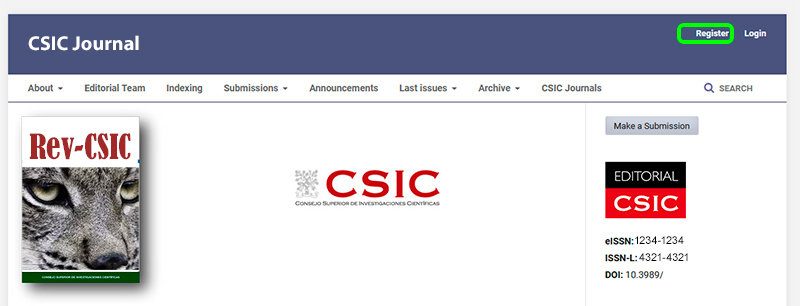
2.- On the registration page you will have to fill in all the fields (the "Family name" field is optional, although highly recommended) using lower case only for your email, username and password. After reading the Privacy Statement you will need to consent to the collection and storage of your data and complete the Captcha. Receiving notifications of new publications and notices is optional.
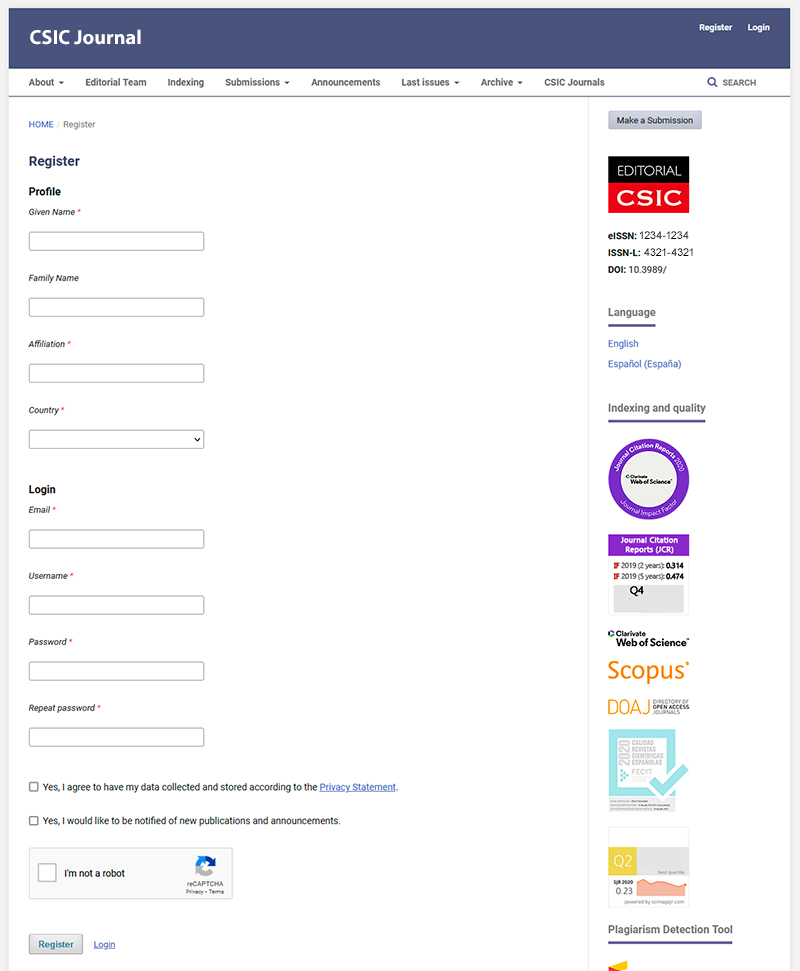
3.- You will receive a message with a link to activate your account at the provided email address. Once activated, you will be able to log in to your account with the credentials you created.
How to send an original manuscript to Scientia Marina
1.- On the magazine's website, log in by clicking on "Login":
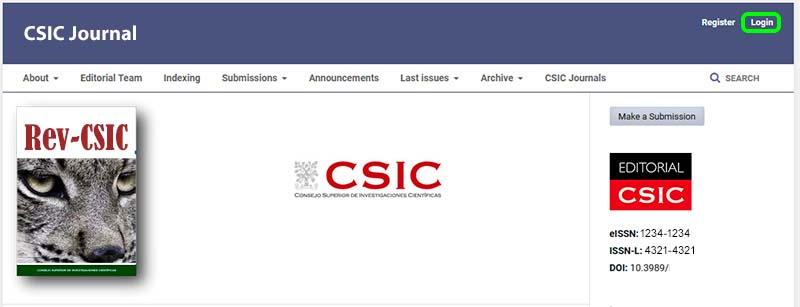
2.- Enter your username and password. Once you return to the magazine's homepage, click on the "Make a Submission" button:
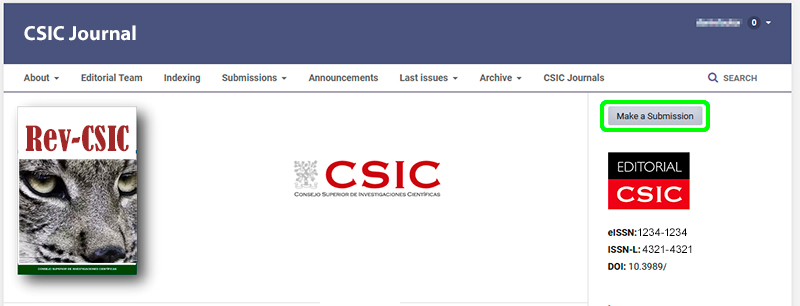
Before submitting, please review the "Submission Preparation Checklist" and read the "Author Guidelines", the "Copyright Notice" and the "Privacy Statement". When you have all the required documents ready, click on the link "Make a new submission".
In subsequent logins, you will be taken to your user dashboard. There press the ‘New Submission’ button to submit a new article. You will be shown any articles received and in process under the ‘My Queue’ tab):

3.- As you will see on the new submissions page, submitting a manuscript is a four-stage process, in addition to a final section with information on follow-up:
3.1.- "1. Start"
At this stage you must select the language in which the article is written and the section of the journal in which you think it would fit, you must indicate that you have prepared all the items on the "Submission requirements" list and, optionally, you may send comments to the editor. You must comply with the terms of the Copyright Statement and the collection and storage of your data as the author of the article in accordance with the Privacy Statement of the Consejo Superior de Investigaciones Científicas (CSIC).
Then press the "Save and continue" button.
3.2.- "2. Upload submission"
In this phase, the files that make up the article and its additional documentation will be uploaded to the management module.
There are three parts to upload each file. In the first one, we will select which component of the article we are going to contribute and we will upload the corresponding file. Once uploaded, click on the "Continue" button. In the second part we will see the file metadata, with the possibility to edit them, but we will click "Continue" without making this edition.
In the third part, select "Add Another File", going back to "1. Upload file" and, without modifying the default option "This is not a revision of an existing file", select the new "Article Component" identifying what it is and uploading the file. Click "Continue" until you reach, once again, step "3. Confirm". This process must be repeated until all the files have been sent, and only when all the material has been uploaded should the "Complete" button be selected.
If after "Completing" the submission we realise that we have forgotten to upload a file, we can do so by selecting the "Upload File" button located in the upper right-hand corner of the "2. Upload Submission" tab:

Once all the submission files have been uploaded, we will press the "Save and continue" button.
3.3.- "3. Enter Metadata"
In this phase the author will enter the metadata of the article according to the journal guidelines. These are:
- Title in Spanish and English. If the article is written in another language, it will be introduced first this language and then in English.
- Summary or abstract in the same languages as the previous item.
- List of contributors. Although it was not necessary when registering as a journal user, in this section it is compulsory for authors to have their ORCID identifier and affiliation correctly indicated. If necessary, the information of additional authors will be added using the link "Add contributor":

- Keywords. The article keywords will be inserted in both languages. The entire list cannot be copied, must be entered one term at a time pressing "Enter" after each one.
- Funding data. The entities that have supported the research published in the article must be indicated. After selecting "Add funder", the name of the funder should be inserted again, which will trigger an internal search that will return the institution standardised name and DOI. If the institution does not have a DOI, it will not be able to register in this field. After entering the grant numbers, click on "Save".
To finish this phase of entering metadata, click on the "Save and continue" button.
3.4.- "4. Confirmation" y "5. Next steps"
In this last phase we will confirm the submission metadata recording linked to the uploaded files. Before clicking on the "Finish Submission" button, we can go back to the previous phases and review the information and files provided to check that they are all correct.
Once we click on the "Finish Submission" button, the article will be sent to the journal and its staff will contact you to continue with the process, as indicated in the "5. Next Steps" section.
How to check a revision report and submit a revised version of a manuscript
Once your submission has been reviewed, the journal's staff will send you a review report. Once received, you must log in to the journal and, in the "Submissions" section of your dashboard, you will be able to check that your submission is in the Review phase and, if the editorial staff has requested, whether it is necessary to make any modifications or revisions to the manuscript:

By clicking on the title of your submission, you will be taken to the workflow of your submission and you will be able to check the information related to the its review. You will find the notifications that the editorial staff has sent you, the attachments that the reviewers may have attached and, if requested, the possibility to provide a new version of the manuscript with the requested modifications by clicking on the "Upload file" button:
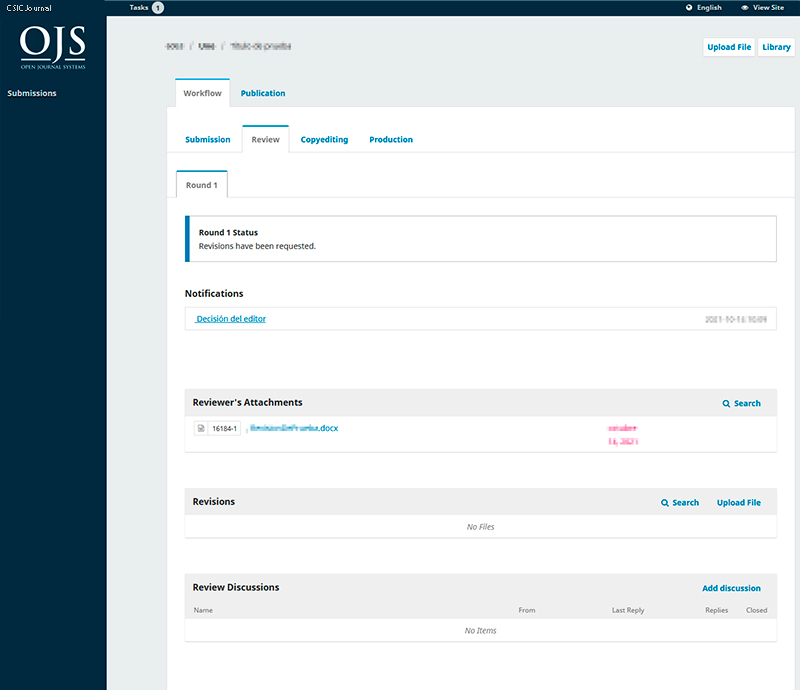
Research data policy
We recommend authors depositing data obtained from the research developed for the preparation of their article in repositories of recognized prestige, specific to the discipline or of a generalist nature. In any case, it must be a FAIR repository (Findable, Accessible, Interoperable, Reusable), preferably in open access.
There are several repositories destined to conserve and disseminate concrete data such as results of surveys, observations, interviews, simulations, automatically collected data, samples, models ... If necessary, authors can consult the Registry of Research Data Repositories re3data taking into account that each repository has its own deposit rules.
Those CSIC authors who would like to deposit their datasets in Digital.CSIC may do so by following these guidelines. They can use the Servicio de Archivo Delegado made available by the Technical Office of DIGITAL.CSIC and the Red de Bibliotecas CSIC.
DIGITAL.CSIC generates DOIs for datasets and associated software and is certified as data repository in re3data and Repository Finder. More information at Política de datos en Digital.CSIC.
If the author has deposited datasets in a repository, he should mention it in the article providing a brief description of the type of data deposited, the name and URL of the repository, the identification code and the data of the license for use and distribution. This information must be included at the end of the article, immediately before the bibliographic listing, under the heading "Data availability".
Download HERE the Good Practice Code in PDF
Download HERE the Authorship Form in PDF
Copyright Notice
© CSIC. Manuscripts published in both the printed and online versions of this Journal are the property of Consejo Superior de Investigaciones Científicas, and quoting this source is a requirement for any partial or full reproduction.All contents of this electronic edition, except where otherwise noted, are distributed under a “Creative Commons Attribution 4.0 International” (CC BY 4.0) License. You may read here the basic information and the legal text of the license. The indication of the CC BY 4.0 License must be expressly stated in this way when necessary.
Self-archiving in repositories, personal webpages or similar, of any version other than the published by the Editor, is not allowed.
Privacy Statement
The Spanish National Research Council (CSIC) has a record of data processing activities. Data collected through this form will be incorporated and processed in the “Gestión de las actividades de producción y distribución de las publicaciones del CSIC” treatment activity of Editorial CSIC, in order to manage the requested service. It is the responsibility of Editorial CSIC to manage this record. If you wish to exercise your rights, please contact us through the contact address Vitruvio, 8, 28006 Madrid, Spain, e-mail address publ@csic.es. Data processing is legitimized by the consent of the affected. The data may not be transferred to third parties except in the cases provided for in current regulations on the protection of personal data. You have the right to file a claim with the Spanish Data Protection Agency. You have the right to withdraw your consent. In the event that you wish -or want to exercise the rights of access, deletion, rectification, limitation or portability- you can do so through the following form. You can also contact the CSIC Officer for Data Protection via email: delegadoprotecciondatos@csic.es












